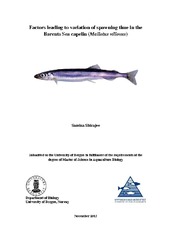Factors leading to variation of spawning time in the Barents Sea capelin (Mallotus villosus)
Master thesis
Permanent lenke
https://hdl.handle.net/1956/10949Utgivelsesdato
2015-11-20Metadata
Vis full innførselSamlinger
Sammendrag
Barents Sea capelin (Mallotus villosus) is a semalparous fish species, and the timing of spawning both in terms of age and season is variable. The present thesis explores potential factors leading to variation in timing of spawning in this key species of the Barents Sea; hereunder whether seasonal timing of spawning to spring or summer is due to an established strategy and genetically (parentally) determined, or simply a variable phenomenon related to changes in environmental conditions. Comparisons of biological characteristics made between spring spawners and summer spawners in five selected years (1977, 1982, 1984, 1985, 1996) demonstrated that summer spawners were significantly younger, smaller (lower length and weight), with a slower somatic growth and lower condition than spring spawning capelin. Both the first year otolith growth and the ratio between first and second year otolith growth was lower in summer- than in spring spawners. First year otolith growth increased with body length at age, whereas such a relationship was not found with the ratio between first and second year otolith growth. Hypothetically capelin hatched in summer would on average have both a lower first year otolith growth and a lower ratio between first and second year otolith growth than capelin hatching in spring due to a much shorter feeding season in their first year of life. Hence, the observed differences in biological characteristics could be interpreted as capelin returning to spawn in the same season they hatched themselves as parentally determined, i.e. summer spawning is an established strategy. This was further explored using data from the late feeding distribution in the Barents Sea during August-October 1976-2012, which demonstrated that capelin with otolith growth characteristics similar to that observed among summer spawners tended to distribute more to the southeast. Feeding and growth conditions normally tend to be worse when moving towards south east, which may explain the slower growth and condition observed among summer spawners. However, the lower condition in summer could also be linked to the longer period spent from the last main feeding season in autumn until the spawning. Over the period 1976-2012 the first year otolith growth and the ratio between first and second year otolith growth were highly variable, and the fluctuations in these parameters were significantly related to population density (capelin biomass), zooplankton availability and temperature. This signifies that age at spawning, and timing of spawning within an established spawning season may vary with climatic changes and stock fluctuations. It is the conclusion of this thesis that it is not very likely that the climate may cause capelin hatched in spring to spawn in summer. However, one cannot exclude that proportions of capelin spawning in summer may vary with changes in environmental conditions, as the climate effect on recruitment may differ between spawning seasons.
